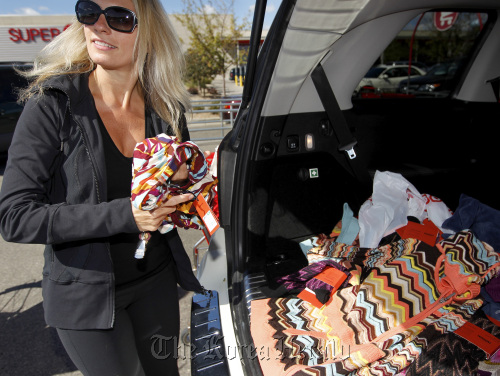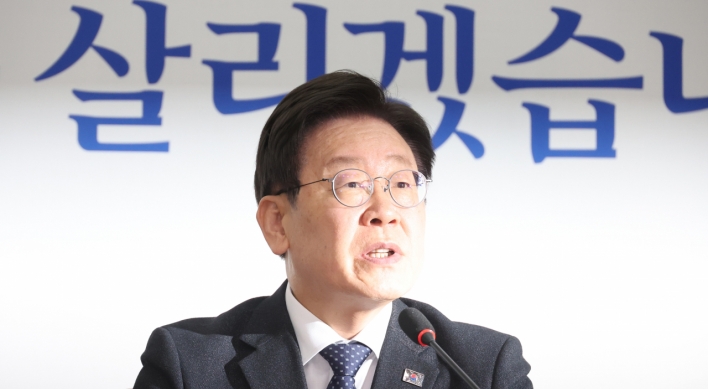LOS ANGELES ― It may seem too good to be true, but Versace is launching an apparel line at fast-fashion retailer H&M in November. Missoni suede heels, with the luxe Italian fashion house’s signature zigzag print, hit the shelves at discount giant Target. Even Vera Wang is designing diamond engagement rings for budget jeweler Zales.
Unlikely pairings, perhaps, but shoppers are seeing more of these bargain-luxury combos these days as elite fashion designers increasingly go mass market.
At a time when signals of economic distress abound, consumers are responding to the partnerships, turning the hype into huge sales. Target’s launch last month of its exclusive Missoni line, for instance, led to Black Friday-type crowds and crashed the company’s website. Nearly all the merchandise, priced from $3 to $600, sold out in days, to the frustration of many shoppers.
Other collaborations, such as H&M’s lines with Roberto Cavalli and Stella McCartney, have also been smash hits, with shoppers camping out overnight to be among the first in line. For two of the retailer’s most recent designer collections, with Jimmy Choo and Lanvin, demand was so high that shoppers were given colored wristbands to stagger their entry times, and the chain set limits on how much customers could buy.
Kelsey Vosough, a junior at Pepperdine University who got a Missoni sweater from Target last month, said she never shops for designer clothes unless she can find them at a bargain. The 19-year-old knows the designer items at low-priced chains aren’t identical to what the brands’ posh clientele buy, but “it’s more affordable and just as cute.”
Designer items at mass merchandisers are nothing new, but the brands signing on nowadays are coming from an elite class of couture houses. Most of them until recently had kept tight control over their labels, releasing a small number of items only to their own boutiques and the most exclusive of department stores.
Unlikely pairings, perhaps, but shoppers are seeing more of these bargain-luxury combos these days as elite fashion designers increasingly go mass market.
At a time when signals of economic distress abound, consumers are responding to the partnerships, turning the hype into huge sales. Target’s launch last month of its exclusive Missoni line, for instance, led to Black Friday-type crowds and crashed the company’s website. Nearly all the merchandise, priced from $3 to $600, sold out in days, to the frustration of many shoppers.
Other collaborations, such as H&M’s lines with Roberto Cavalli and Stella McCartney, have also been smash hits, with shoppers camping out overnight to be among the first in line. For two of the retailer’s most recent designer collections, with Jimmy Choo and Lanvin, demand was so high that shoppers were given colored wristbands to stagger their entry times, and the chain set limits on how much customers could buy.
Kelsey Vosough, a junior at Pepperdine University who got a Missoni sweater from Target last month, said she never shops for designer clothes unless she can find them at a bargain. The 19-year-old knows the designer items at low-priced chains aren’t identical to what the brands’ posh clientele buy, but “it’s more affordable and just as cute.”
Designer items at mass merchandisers are nothing new, but the brands signing on nowadays are coming from an elite class of couture houses. Most of them until recently had kept tight control over their labels, releasing a small number of items only to their own boutiques and the most exclusive of department stores.

“There’s been a paradigm shift in what designers can and cannot do today, which is why this works,” said Eli Portnoy, a brand strategist and marketing expert. “Mixing and matching price points is a much more accepted thing, which allows a designer to still be high-end but also do quality, good-looking design at the lower end as well.”
Such collections are a “win-win situation” for everyone involved, said Jennifer Ward, a spokeswoman at H&M. “It really brings fashion to another level because it feels attainable,” she said. The Swedish retailer’s upcoming Versace collection will be priced at $30 to $400; by comparison, a Versace black sheath dress at Neiman Marcus costs $2,925.
Forever 21, which last year joined the trend by releasing an apparel line by Brian Lichtenberg, a Lady Gaga favorite, is launching a new collection with up-and-coming designer Rory Beca this month. And last month, Starbucks said it had teamed up with Alexander Wang and other designers for a line of T-shirts.
When Lanvin partnered with H&M last year, Alber Elbaz, artistic director of the Parisian fashion house, said the line would be “not just a dress for less.”
“I have said in the past that I would never do a mass-market collection, but what intrigued me was the idea of H&M going luxury rather than Lanvin going public,” he said at the time. “This has been an exceptional exercise, where two companies at opposite poles can work together.”
Shoppers who have long coveted the pricey brands but couldn’t afford them are thrilled. The availability of the brands at everyday retailers has incited a kind of frenzy, especially for products that are around for only a few weeks.
On the date of the Missoni for Target launch last month, Alissa Kerslake, 25, set her alarm clock for 30-minute intervals in the middle of the night because the discounter hadn’t announced exactly what time the products would be available online. The Burbank, California, resident said she always follows Target’s collaborations, such as past lines with Rodarte and Alexander McQueen.
At 3:30 a.m., Kerslake finally saw what she was looking for. She bought about two dozen items, including clothes, plates, martini glasses and serving trays, spending $700. That was a lot of money, she admitted, but essentially “I got the whole collection for the price of one piece at Neiman.”
Not to be confused with Hollywood celebrity lines, which can be hit-or-miss and often lack credibility with shoppers, designer partnerships have in part proliferated because the sluggish economy has forced retailers and fashion’s top tier to think of new ways to drive sales.
The trend also feeds into what has been dubbed the “democratization of fashion,” making it cool to wear luxury brands paired with discount finds.
“The future of the fashion industry is about extremes―very high and very low,” Elbaz said. “It’s not about bridges; they are the first to collapse.”
By Andrea Chang
(Los Angeles Times)
(MCT Information Services)



![[Herald Interview] 'Amid aging population, Korea to invite more young professionals from overseas'](http://res.heraldm.com/phpwas/restmb_idxmake.php?idx=644&simg=/content/image/2024/04/24/20240424050844_0.jpg&u=20240424200058)







![[Hello India] Hyundai Motor vows to boost 'clean mobility' in India](http://res.heraldm.com/phpwas/restmb_idxmake.php?idx=644&simg=/content/image/2024/04/25/20240425050672_0.jpg&u=)





![[Today’s K-pop] NewJeans' single teasers release amid intrigue](http://res.heraldm.com/phpwas/restmb_idxmake.php?idx=642&simg=/content/image/2024/04/26/20240426050575_0.jpg&u=)